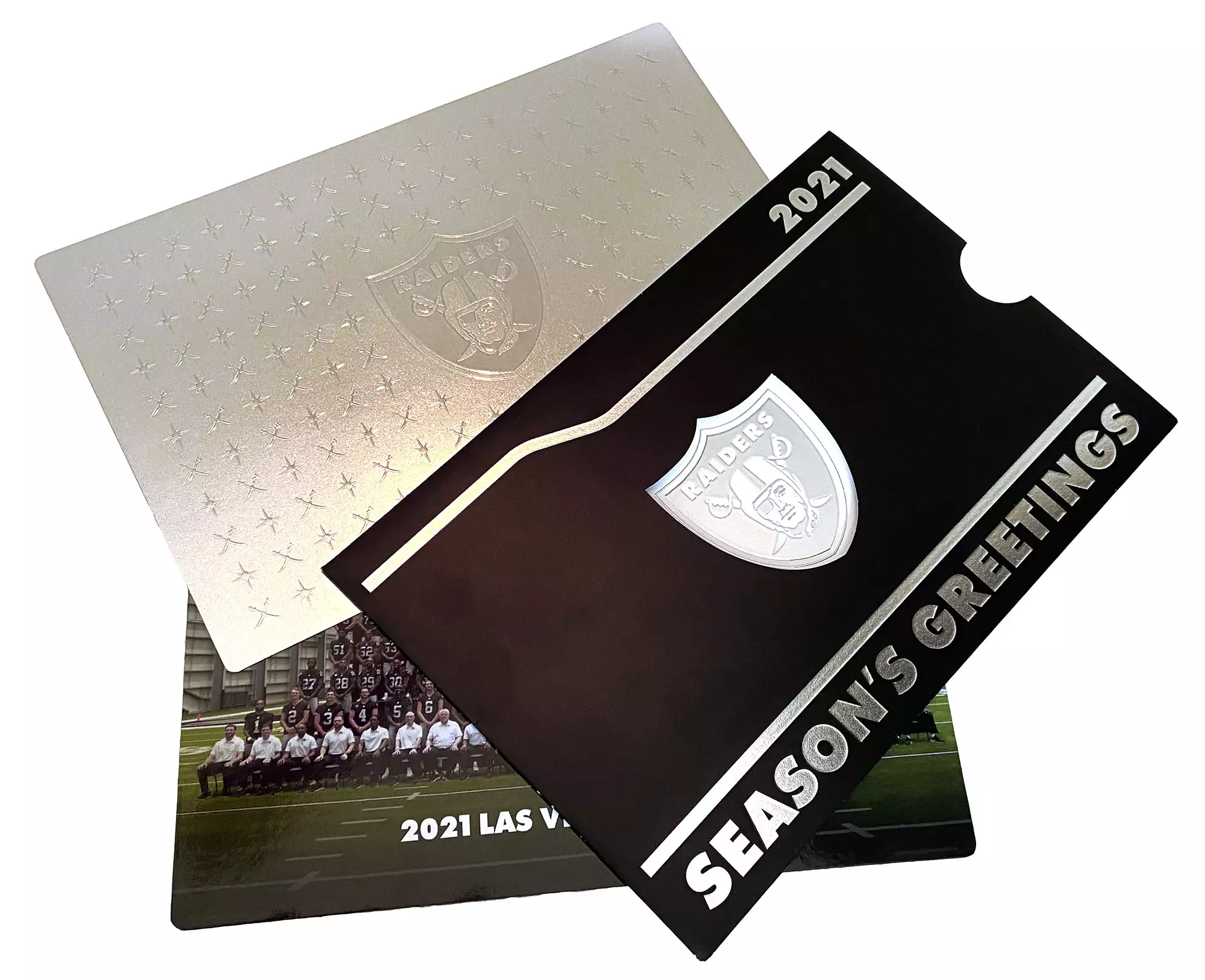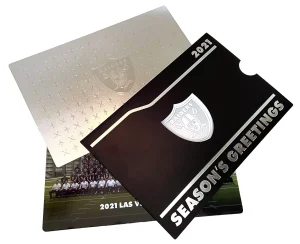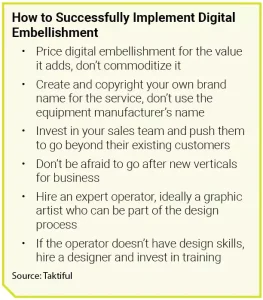
By Hallie Forcinio, contributing writer, PostPress
Digital inkjet embellishment reproduces effects that are either not possible or prohibitively expensive on traditional analog equipment. Capable of creating physical, visual and tactile effects in one pass and economically handling short runs, digital enhancement capabilities open doors to new business. Options include tactile, foil, metallic, glitter, spot and holographic effects, as well as diecutting and embossing. These additional capabilities can be an excellent complement for trade print finishers and other Print Service Providers (PSP’s) and open up opportunities for short-run digital print work for embellishment applications.
Textured finishes, created with 3D varnish, capitalize on the sense of touch to provide a memorable impression for the consumer. Depictions of cobblestones evoke the texture of cobblestones, strings on a guitar feel real, tires feel like rubber and sand feels gritty. For example, a furniture catalog cover produced by Elite Print Finishing (EPF), Burlington, North Carolina, added texture to the pillows, a 3D effect to the windowpane and a metallic effect to the hardware. “Most folks pick up the printed piece and start petting it,” said Steven Roberts, president at EPF. “You achieve interaction with the consumer before one word is read.”
Digital enhancement technology allows printers and trade finishers to serve a fast-growing market, short runs, and also enables jobs that were digitally printed to be digitally enhanced, boosting efficiency and enabling greater personalization of the printed piece and quick production of prototypes. “A lot of times, we sample three or four options,” Roberts said. “So many projects could be so much better with digital enhancement,” he added.
Invitations, real estate brochures, book covers, packaging for cannabis products and trading cards are growing applications. A brochure for a luxury house being sold for $10 million provides an example. Digital enhancement can show what the tile floor feels like and economically accommodate the short run of 50-100 pieces.
Going digital
EPF, which handles both commercial print and packaging jobs, particularly for the pharmaceutical and nutraceutical industries, looked at the technology for three or four years before deciding to buy a digital embellishment system. Before making the purchase, the company considered return on investment, whether it would be a good fit for its customer base and how much business would be needed each month to make it profitable. It also looked at equipment from various suppliers.
Roberts recalled, “The printed sheets were beautiful, but I couldn’t see customers paying for it. Several existing jobs we showed to an equipment provider were deemed ‘not a good fit’ for the system. But we realized there was new business out there, and we could create a market for it. It changed the way we do business.”

The company chose equipment from MGI Digital Technology and installed it in February 2020 just before the pandemic started. With no personal visits possible to show off the operation and output of the new system, the company shifted to online meetings to spread the word about its new capabilities and sent out samples showing the effects the equipment could produce. “We had prospective customers calling us,” Roberts said. This was new business rather than existing business wanting to convert jobs to digital enhancement. He added, “All of a sudden, we could produce effects we couldn’t do before. That was the market we wanted to be in.”
Carlson Print Group, Eden Prairie, Minnesota, a division of American Spirit Corp., also wanted to be able to offer embellishments beyond its existing capabilities and installed a digital embellishment system from Scodix in 2021 so it could add embellishments more cost-effectively to the 28 x 40″ sheets printed on its ultraviolet (UV) offset printing presses. “It gives the sales staff another tool in their toolbox,” explained Earl Guinter, sales manager, at the specialty printer, which offers full finishing capabilities.
The Anstadt Company, print and marketing execution specialists in York, Pennsylvania, also chose a unit from Scodix. The fourth installation of its kind in late 2016, their Scodix Ultra2 Pro digital enhancement press with foil station has been fully operational since January 2017. The company’s goal was to expand options for creativity and “add value to print and make it … an exciting, viable means for our customers to communicate that could not be easily substituted by digital marketing channels,” recalled Matthew R. Doran, president and CEO at Anstadt. He adds, “We … have years of experience with creating and producing complex print materials that involve areas such as foil stamping, embossing, diecutting, etc., so this was a great next step in our evolution.”
While the ability to add effects such as embossing, spot ultraviolet varnish, 3D foil and specialty diecuts is impressive, implementation of digital enhancement presses is not without challenges. There’s a learning curve for the print sales team, operators and designers. “Artists don’t understand digital embellishments,” said Kevin Abergel, president at Taktiful, Melbourne, Florida, a consultancy of digital embellishment sales and marketing specialists with teams in the United States, Japan, Mexico and Canada. One of its services is teaching designers how to design for digital embellishments. This includes how to set up files correctly as well as tips for incorporating digital embellishments. “Creating a great file is 99% of the battle,” he noted.
Since virtually no designers were familiar with the capabilities of the equipment, EPF hired a design firm and trained the designers. Roberts explained, “We outsource the design to them. They understand the capabilities of the machine and design
specifically for it.”
Guinter agrees education about digital embellishments is essential. “Customers and consumers might see the end result, touch it and feel it, but they are not sure how it was accomplished and don’t understand what it entails,” he said. The terminology is unfamiliar, and it can be difficult to discern differences among effects like clear polymer versus foil or cast and cure. To solve this problem, Carlson Print Group is developing a marketing kit and adopted its own brand name – Sense-ational – to showcase the different polymer effects it can achieve on its Scodix Ultra 6000 unit. “We also are taking some previous artwork from clients that have used specialty print in the past, adding embellishments and sending it to them to show what the equipment can do,” Guinter said. “We’ve had some success with that.”
EPF has taken a similar approach. “We’ve developed a brochure that provides a tutorial about [our Elite3D] technology and what we need from customers to ensure a successful run,” Roberts said.
Another challenge to implementing digital enhancement technology is a lack of standards. “Everyone interprets workflows differently,” noted Abergel.
Another issue is the temptation to price according to the usual cost-plus model. “Don’t commoditize the technology,” warned Abergel. “Pricing should be in accordance with the value it delivers.”
Finally, care must be taken to select the right papers, films, foils and coatings and understand what the machines can and cannot do. Typically, coated or laminated sheets are required. Uncoated sheets tend to be too absorbent and must be primed or otherwise treated.
Implementing digital enhancement has increased EPF’s customer base. It’s bringing in 20 or 30 more jobs per week and the equipment sometimes runs 24/7. Some of the jobs must be cut on the guillotine cutter, stitched or diecut and glued. So, it’s increased workflow across the shop. It’s also created a challenge because a job with 10,000 sheets may be followed by one with 250 sheets. “One of our objectives this year is to find some equipment better suited for short runs,” reported Roberts.
 Digital or analog?
Digital or analog?
Digital embellishment complements rather than competes with analog technology. “It’s not one or the other,” Abergel said. Sometimes, the two are complementary. Digital enhancement technology can provide a rapid prototype and help sell jobs that will run on analog equipment. Jobs may start on a digital embellishment machine but as quantities grow it may be more feasible to move to more conventional foil stamping or possibly cold foil. “Being able to see what the final piece will look like helps make the sale,” he added.
When deciding whether a job should be finished digitally or traditionally, several factors must be considered including substrate, format and quantity as well as the level of embellishment. “Generally, the sweet spot [for digital] is under 10,000 sheets,” Guinter said. However, the breakeven points can vary from 5,000 to 20,000 depending on the level of embellishment involved.
Conclusion
Despite the capabilities of digital embellishments, conventional foil and spot coating have not declined. Roberts explained, “There aren’t that many jobs where it’s practical to switch from analog to digital [embellishment]. Digital opens new doors. You have to quit concentrating on the business you have, to concentrate on the business you don’t have. Adding digital embellishment technologies has actually increased the work moving through our shop.”
Digital print embellishment capabilities have generated new business for Anstadt too. All of their core product categories from packaging, direct mail and signage to marketing and promotional collateral have benefited. Doran reported, “We have been able to create new, exciting areas of opportunity involving print … that may otherwise have never come about. Ultimately, print embellishment has opened doors to new customers looking to extend their brand appeal … in market-differentiating ways.”
Reactions to digital enhancement capabilities have been extremely favorable. Guinter said, “We need to keep pushing it and creating a buzz around it. When people see digital embellishment, they gravitate to ideas of what it can do.” What that does is generate sales.

